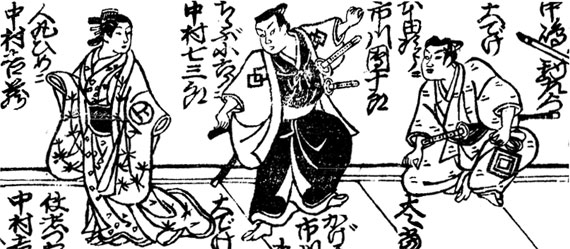| ICHIKAWA DANJ█Rď III |
|
Stage names:
Guild: Naritaya Line number: SANDAIME (III) Poetry names: Tokuben, Sansh˘ Existence: 1721 ~ 27th of the 2nd lunar month of 1742 [1] Connection: Grandfather: Ikushima Shingor˘ Father: Mimasuya Sukejűr˘ I Adoptive father: Ichikawa Ebiz˘ II Career: 1721: born in Edo. He was the son of Ichikawa Danjűr˘ II's disciple Mimasuya Sukejűr˘ I and he was called Mimasuya Suketar˘. 26th day of the 3rd lunar month of 1725 [2]: his father Mimasuya Sukejűr˘ I died. Afterwards, he was adopted by Ichikawa Danjűr˘ II. 11th lunar month of 1727: he received the name of Ichikawa Masugor˘ at the Nakamuraza, performing in the kaomise drama "Yatsumune Taiheiki", which celebrated the return of ďtani Hiroji I (along with the Kamigata actor Kirinami Onoe) in Edo after 5 years spent in Ky˘to. 11th lunar month of 1734: Masugor˘ played at the Ichimuraza the role of Mitachi Gontar˘ in the kaomise drama "Michinoku Yunzei Genji". 1st lunar month of 1735: Masugor˘'s rank in the Edo hy˘banki, koyaku section, was j˘-j˘-kichi (superior - superior - excellent) [visual]. 11th lunar month of 1735: great shűmei for the Naritaya at the Ichimuraza; Ichikawa Danjűr˘ II, Ichikawa Masugor˘ and Matsumoto Shichiz˘ I took the respective names of Ichikawa Ebiz˘ II, Ichikawa Danjűr˘ III and Matsumoto K˘shir˘ II. The new Danjűr˘ played the role of Seiryűmaru Aratora in the kaomise drama "Kongen Nana Komachi". 1st lunar month of 1736: Danjűr˘'s rank in the Edo hy˘banki, tachiyaku section, was j˘-j˘-(shiro)kichi (superior - superior - (white) excellent) [visual]. Summer 1736: Danjűr˘ played in the same theater the role of Ike no Sh˘ji in the drama "T˘kaid˘ Yukumi Guruma", whose plot and characters belong to the "Oguri Hangan" world. His stage partners are ďtani Hiroji I (the thief Mokuzu no Sanpei), Segawa Kikunoj˘ I (Sanpei's wife), Segawa Kikujir˘ I (the courtesan Onikage), Ichimura Takenoj˘ IV (Oguri Hangan) and Ichikawa Ebiz˘ II (Got˘ Saemon). 9th lunar month of 1736: Danjűr˘ played in the same theater the role of Mejiro no Fud˘ (white-eyed Fud˘) in the drama "Yonin Fud˘" ('The Four Deities Fud˘'); his stage partners in the roles of Meguro no Fud˘ (black-eyed Fud˘), Meaka no Fud˘ (red-eyed Fud˘) and Meao no Fud˘ (blue-eyed Fud˘) were Ichikawa Ebiz˘ II, ďtani Hiroji I and Ichimura Takenoj˘ IV. 11th lunar month of 1736: Danjűr˘ played at the Kawarasakiza the role of Murakami Hikoshir˘ in the kaomise drama "Junpű Taiheiki". 11th lunar month of 1737: the play "Dan no Ura Kabuto Gunki" was staged for the first time in Edo, at the Kawarasakiza, as a kaomise drama entitled "Urűzuki Ninin Kagekiyo"; Danjűr˘ played the role of Honda no Jir˘ [casting]. 11th lunar month of 1738: Danjűr˘ played at the Ichimuraza the role of Murakami Hikoshir˘ in the kaomise drama "Mitsugibune Taiheiki". 3rd lunar month of 1739: Danjűr˘ played in the same theater the role of Sukeroku in the drama "Sukeroku J˘mon no Hanabusa"; the roles of Ikyű and Agemaki were played by Ichikawa S˘zabur˘ I and Tomizawa Montar˘ I. 11th lunar month of 1739: Danjűr˘ performed at the Ichimuraza in Fujimoto Tobun's kaomise drama "Tokiwagi Taiheiki". 11th lunar month of 1740: Danjűr˘ played at the Nakamuraza the role of Shinozuka Gor˘ in the kaomise drama "Miya Bashira Taiheiki", which celebrated the shűmei of Ichikawa Danz˘ III and Tomizawa Tatsujűr˘. 3rd lunar month of 1741: Danjűr˘'s rank in the Edo hy˘banki, tachiyaku section, was j˘-j˘-(hanshiro)kichi (superior - superior - (half-white) excellent) [visual]. 8th lunar month of 1741: last performance in Edo before going to ďsaka; Danjűr˘ performed in the drama "Uruoi Seiwa Genji" but it was not well received by the audience. 10th lunar month of 1741: Ichikawa Ebiz˘ II and Danjűr˘ went together to ďsaka to perform for the enormous amount of 2000 ry˘ at the ďnishi no Shibai. 11th lunar month of 1741: Danjűr˘ played at the ďnishi no Shibai the role of Shinozuka Iga-no-Kami in the kaomise drama "Bankoku Taiheiki", which included the "Uir˘ Uri" scene and was produced by Sadoshima Ch˘gor˘ I. 12th lunar month of 1741: Danjűr˘ suddenly fell ill and decided to go back to Edo. 1st lunar month of 1742: Danjűr˘'s rank in the ďsaka hy˘banki, tachiyaku section, was j˘-j˘-(hanshiro)kichi (superior - superior - (half-white) excellent) [visual]. 27th of the 2nd lunar month of 1742 [1]: Danjűr˘ died in Edo. Comments: Ichikawa Danjűr˘ III was a promising Naritaya actor, trained in the aragoto style, who unfortunately died too young. [1] The 27th day of the 2nd lunar month of the 2nd year of the Kanp˘ era was the 2nd of April 1742 in the western calendar. [2] The 26th day of the 3rd lunar month of the 10th year of the Ky˘h˘ era was the 8th of May 1725 in the western calendar. |
 |
|
Nakamura Kichiz˘ I (left), Nakamura Shichisabur˘ II (center) and Ichikawa Danjűr˘ III (right) playing the roles of Princess Hitomaru, Chichibu no Korokur˘ and Honda no Jir˘ in the kaomise drama "Urűzuki Ninin Kagekiyo", which was staged in the 11th lunar month of 1737 at the Kawarasakiza Print made by Okumura Toshinobu around 1731 Print made by Torii Kiyomasu (1735 ~ 1741) The Ichikawa Danjűr˘ line of actors |
|
|
| Contact | Main | Top | Updates | Actors | Plays | Playwrights | Programs | Links | FAQ | Glossary | Chronology | Illustrations | Prints | Characters | Derivatives | Theaters | Coming soon | News |